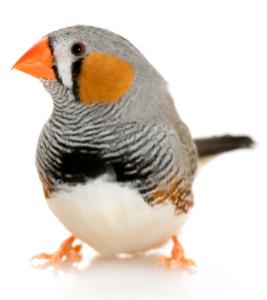
Country of Origin: Australia
Size: 20 cm in length from the beak to the tip of the tail.
Life span: 5-17 years
Scientific Name: Poephila guttata castanotis
Description
Gray back and white underbelly; bright orange or red beak and legs; black "teardrops" on the edge of the cheek patch (males); small black band crossing the chest; brown and white spots just beneath folded wings; white horizontal marks on black tail feathers. There are many light colored mutations. Females lack cheek patches.
Temperament
The Finches are friendly birds that prefer the company of others of their kind. These curious little birds don/t appreciate the contact with humans. They are active birds that like to fly around in the aviary. Each finch has it/s own song, characterized by the repetition of small beeps. Females don’t have singing ability.
Diet
Mixed millets, canary seed and greenfood.
Special Needs
Don't breed females until 9 to 10 months old. Separate cocks and hens during winter, preferably indoors in unheated, frost-free area.
Excercise
Zebra finches love to fly and need a minimum of 20 inches of horizontal space to accommodate this natural behavior. They appreciate as big a flight zone, as you can give them. Although very social with their own species, in fact, needing this social interaction, finches do not like to interact very much with humans.
Cage Life
The Zebra Finch is adaptable, social, vivacious, hardy and easily tamed. Male has bright, vigorous trumpeting song. Good for all types of aviaries and large cages. Prolific breeders in outdoor aviaries, but limit to three, per season to avoid egg binding and weak young. Remove all nesting materials (grass, plant fibres, feathers, wool), as soon as the nest is completed, to prevent further construction. The free nest is bottle-shaped, with an extrance tunnel. Likes to use all types of nest boxes. Lays 4 to 5 eggs, incubation, 13 to 16 days by both partners, fledging 20 to 22 days. Independent 3 weeks after it has flown out. Hang nest boxes near roof of cage or aviary to prevent birds from making another nest on top of it.



